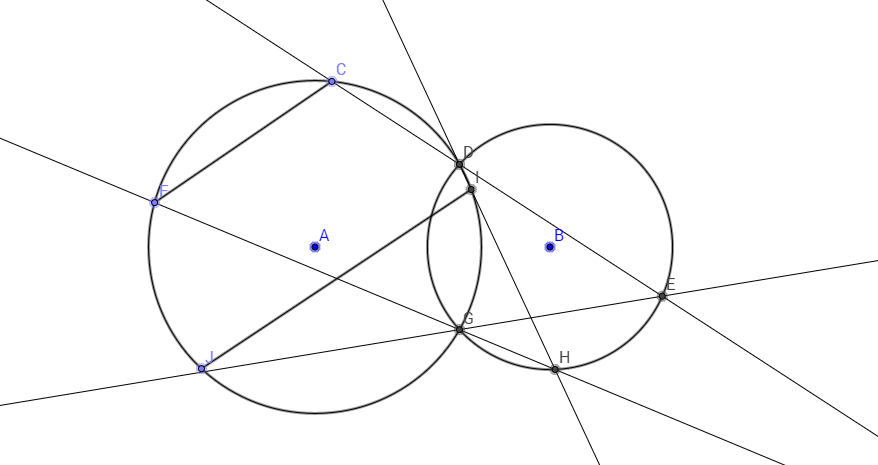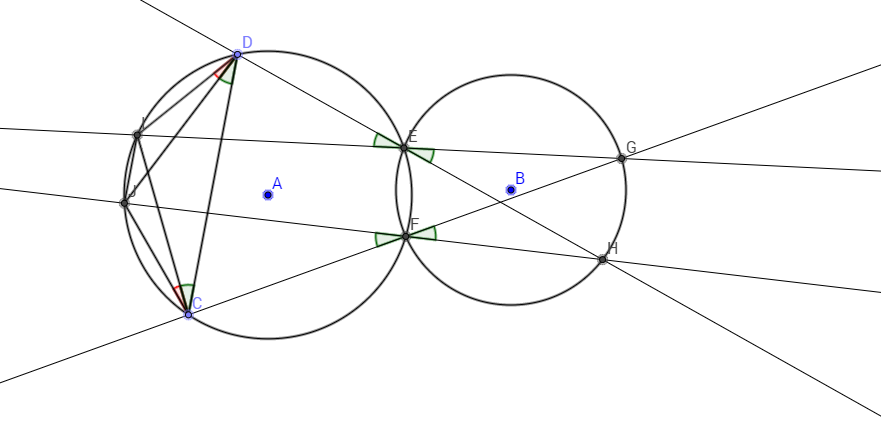Can you prove this?
 There are two intersecting circles G1 and G2 with centres at A and B respectively. They meet at points D and G. You choose any two points C and F on the cirle G1. From C, you draw a line through D to meet G2 at E. Through E, draw a line passing through G to meeet G1 at J. Now, you draw a line from F through G to meet G2 at H. From H, you draw a line through D to meet the circle circle at I. Connect C and F amd I and J. Prove that IJ is parallel to CF.
There are two intersecting circles G1 and G2 with centres at A and B respectively. They meet at points D and G. You choose any two points C and F on the cirle G1. From C, you draw a line through D to meet G2 at E. Through E, draw a line passing through G to meeet G1 at J. Now, you draw a line from F through G to meet G2 at H. From H, you draw a line through D to meet the circle circle at I. Connect C and F amd I and J. Prove that IJ is parallel to CF.
This figure is part of the solution:

I changed the label of F to D. So now, it's prove that CD is parallel to IJ. Start out with angle JCI, which is equal to angle JDI. So now, we only have to show that angle JDC is equal to angle ICD and we get an isosceles trapezium CDIJ and we're done. Angle JDC is equal to angle JFC which is equal to HFG which is equal to angle HEG, which is equal to angle IED which is equal to angle ICD.
Q.E.D.
If you want a more challenging version of this, then checkout my problem here
Easy Math Editor
This discussion board is a place to discuss our Daily Challenges and the math and science related to those challenges. Explanations are more than just a solution — they should explain the steps and thinking strategies that you used to obtain the solution. Comments should further the discussion of math and science.
When posting on Brilliant:
*italics*or_italics_**bold**or__bold__paragraph 1
paragraph 2
[example link](https://brilliant.org)> This is a quote# I indented these lines # 4 spaces, and now they show # up as a code block. print "hello world"\(...\)or\[...\]to ensure proper formatting.2 \times 32^{34}a_{i-1}\frac{2}{3}\sqrt{2}\sum_{i=1}^3\sin \theta\boxed{123}Comments
This is just a quick hunch, given two such circles G1 and G2 intersecting at points D, G, given any point E on G2, and extending lines ED and EG to meet G1 at points C and J, the chord length of CJ is constant. The rest of the proof follows.
I'll back to this a little later with maybe a graphic to show this.
Okay, here's the graphic. With a bit of angle chasing, it's easy to show that, given angles a,b formed by two intersecting circles, for any x formed by arbitrary point E, the angle subtended by chord CJ is a+b. Therefore, the length of chord CJ is constant for any E. With this, it's straightforward to show that IJ is parallel to GF.
Log in to reply
Wow! Really awesome proof. This question is not original and is from last year's entrance exam to a college over here. I couldn't solve it when I was going through the paper yesterday. I too tried to relate it to an isosceles trapezium, but I gave up. I had to look up the solution to this question to get the method.
Their method made it seem so simple that I felt like smacking myself in the head. I have a figure that I'll post which makes it really obvious. I changed the labels, so now it's prove that CD is parallel to IJ.
Log in to reply
If you're up for one more challenge, which is sort of related to this problem, check out this one here.
It might help to make a clearer picture using Geogebra. I adjusted the points so that it'd look harder, but sometimes in geometry, the best investment of your time is in drawing the figure.
That's an interesting Geom question!
Log in to reply
Glad you liked it.
It is an interesting GEOMETRIC question, in which I had seen!!!!!!
Log in to reply
Why didn't you share it then? I'm sure that it would had attracted a lot of people. Did you write the exam for CMI? That's where I got the question from : )
I shared it now,no I didn't written the exam of CMI,that's good !are you happy for sharing this question
Log in to reply
I think you misunderstood me. I meant to say why didn't you post it yet?
Log in to reply
Ok, I am sorry for this mistake